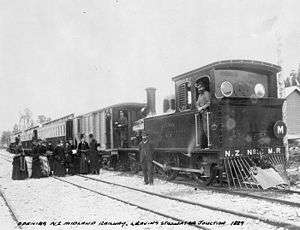Stillwater–Westport Line

The Stillwater Ngakawau Line (SNL), formerly the Stillwater - Westport Line (SWL) and the Ngakawau Branch, is a secondary main line, part of New Zealand's national rail network. It runs between Stillwater and Ngakawau via Westport on the West Coast of the South Island. It was one of the longest construction projects in New Zealand's history, with its first section opened in 1889 but the full line not completed until 1942.
Construction
A railway link from Greymouth east to Brunner was opened in 1876, but work on a link from this point to Westport became delayed for ten years by disputes over the best route to link the West Coast with Nelson and Canterbury. Ultimately, the New Zealand Midland Railway Company (NZMRC) was formed to construct the route, and in 1886, work recommenced. The junction of the route to Westport and the Midland Line to Canterbury was established just east of Brunner in Stillwater, and the NZMRC put most of its energy into the first portion of the SWL from Stillwater to Reefton. This was due to the comparatively easier terrain faced by the route in the valley of the Grey River, and in 1889, the line was opened to Ngahere. On 29 February 1892, the NZMRC opened the line all the way to the south bank of the Inangahua River, directly opposite Reefton, and with the Stillwater - Reefton portion complete in their view, they redirected their energy to the Midland route from Stillwater to Otira.
In the mid-1890s the NZMRC ran out of funds and, after a dispute in the courts, was taken over by the central government. Work on the SWL recommenced in the 20th century, with the Inangahua River bridged, the present-day Reefton station established, and a further section to Cronadun opened in 1908. At the Westport end, construction also commenced, with a 9 km line opened in 1912 from Westport to Te Kuha at the western end of the Lower Buller Gorge. In 1914, the line from Cronadun reached Inangahua Junction, where the NZMRC intended its lines to Westport and Nelson to diverge (in fact, Inangahua remained the probable site for a junction until all work on the Nelson Section ceased in the 1930s). However, the outbreak of World War I brought a halt to construction with only the section through the Buller Gorge to complete.
The Buller Gorge posed many difficulties for construction, and little work was done on the line for over two decades. Only after the 1935 election brought about a change in government was there a serious push to complete the line (as well as the similarly postponed Main North Line). The outbreak of World War II created further delays on construction, but this time, work continued through wartime, the 'last spike' ceremony being on 2 December 1941.[1] The Public Works Department was in charge of construction and were able to operate trains the length of the line by July 1942, but ownership of the route was not transferred to the New Zealand Railways Department until 5 December 1943.
Operation
Before the line was completed, mixed trains operated on sections open for service, and between August 1936 and August 1938 a daily morning railcar service was provided from Hokitika on the Ross Branch to Reefton and return by a diminutive Leyland diesel railcar.[2] Once the line was completed Vulcan railcars operated from Westport to Stillwater, where they connected with services to Christchurch, and a local service ran between Greymouth and Reefton. The poor roads in the region meant there was more demand for a passenger service than on many other rural routes in New Zealand that lost their passenger services by 1940, but road upgrades led to increasing competition from the private car and all passenger services on the line ceased in 1967.
Commodities such as coal, timber, and cement have been the mainstay of freight on the line, and in the 1950s, when coal was still shipped from Westport and Greymouth, the occasional closure of one port meant every operational locomotive on the West Coast was pushed into duty to haul coal up or down the SWL to the other port. Today, the coal traffic still exists in substantial qualities, but it is no longer shipped from West Coast ports; it is carried by train to the deep harbour in Lyttelton on the east coast.
When the line was completed, UC class steam locomotives were utilised on the line, with the B and BA classes introduced in 1957. This was the last mainline duty performed by the B and BA locomotives, and as bridges on the SWL were strengthened, they were displaced in the 1960s by the heavier A and AB classes. In 1969, the SWL became one of the last lines in New Zealand to be dieselised, with the DJ class introduced. In the 1980s, DC locomotives were also placed into service on the line.
One notable feature was the necessity to bank heavy trains heading south from Reefton to Stillwater due to the difficult uphill grade. This was a common feature during the era of steam locomotives, and although banking was dispensed with on most lines when the conversion to diesel-electric motive power was made, the SWL was initially an exception. Some trains had two DJ class locomotives at each end, but this practice has now come to an end, with trains usually formed and loaded in such a way that banking is unnecessary.
References
- ↑ "Last Spike Driven". Evening Post. 1941-12-03. p. 13. Retrieved 2016-05-18.
- ↑ Pahiatua Railcar Society, "Early New Zealand Railcars: RM 20 and 21" Archived 16 August 2006 at the Wayback Machine., accessed 27 January 2008.
- Churchman, Geoffrey B., and Hurst, Tony; The Railways of New Zealand: A Journey Through History, HarperCollins Publishers (New Zealand), 1991 reprint